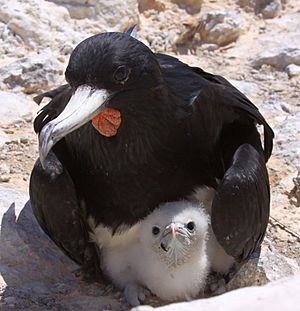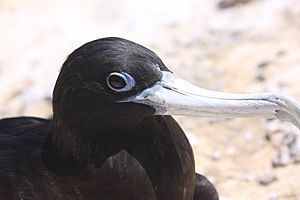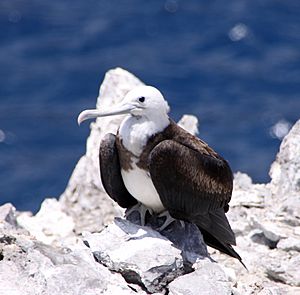Ascension frigatebird facts for kids
Quick facts for kids Ascension frigatebird |
|
|---|---|
 |
|
| Male with chick at Boatswain Bird Island | |
| Conservation status | |
| Scientific classification | |
| Genus: |
Fregata
|
| Species: |
aquila
|
| Synonyms | |
|
|
The Ascension frigatebird is a cool seabird. It lives in the tropical Atlantic Ocean. These birds breed on Boatswain Bird Island and Ascension Island. They are part of the Frigatebird family.
Ascension frigatebirds are big birds. They are brownish-black and have a long, forked tail. Their wings can spread about 2 meters (6.5 feet) wide! Male birds have a bright red pouch under their throat. They puff this pouch up like a balloon to attract a mate.
Female frigatebirds are a bit bigger than males. They often have a brown band across their chest. These birds eat fish they catch while flying over the ocean. They especially love flying fish. Sometimes, they even chase other birds to make them drop their food! This is called kleptoparasitism.
Contents
Meet the Frigatebird: What's in a Name?
The Ascension frigatebird was first described by Carl Linnaeus in 1758. He was a famous scientist who gave many animals their scientific names. The name "frigatebird" comes from French sailors. They called the bird La Frégate, which means a fast warship. This name fits because frigatebirds are very fast and agile flyers.
The scientific name aquila is a Latin word. It means "eagle." This part of the name refers to the bird's dark feathers. It also points to its habit of catching prey.
Ascension Frigatebird: What Do They Look Like?
The Ascension frigatebird is a dark-colored seabird. It has long, thin, pointed wings. Its tail is long and deeply forked. It also has a long, hooked beak.
These birds are about 89 to 96 centimeters (35 to 38 inches) long. Their wingspan can be up to 2 meters (6.5 feet). They weigh around 1.25 kilograms (2.75 pounds).
- Male Birds: Males are completely black. Their neck and back feathers have a shiny green color. They have a bright red throat pouch. This pouch inflates when they want to find a mate. Their beaks are pale blue-grey. Their eyes are dark brown.
- Female Birds: Females are brownish-black. They do not have the shiny green feathers. Many females have a brown patch on their chest. Some females have white on their chest. This might be a sign that they are younger breeding females.
Where Do Ascension Frigatebirds Live?
Most Ascension frigatebirds nest on Boatswain Bird Island. This small island is about 250 meters (270 yards) off the coast of Ascension Island. The island has a plateau on top where they build their nests.
These birds used to nest on Ascension Island itself. But wild cats were brought to the island in 1815. These cats hunted the frigatebirds. This caused the birds to disappear from Ascension Island.
Good news! Between 2002 and 2004, all the wild cats were removed. Because of this, the frigatebirds started to come back. In 2012, two pairs nested on Ascension Island again. By 2014, twelve nests were found on Letterbox Peninsula. This shows that the birds are returning to their old homes!
When they are not breeding, these birds fly far across the ocean. They are often seen off the coast of West Africa. They eat fish and other small sea creatures. Sometimes, they even eat small turtles.
There have been a few rare sightings of these birds far from their usual homes. One young frigatebird was found in Scotland in 1953. Another young one was seen in Scotland in 2013. In 2014, one was tracked by satellite near Brazil.
Protecting the Ascension Frigatebird
Scientists counted the Ascension frigatebird population in 2001–2002. They found about 6,250 breeding females. Since females usually breed every other year, this means there are about 12,500 birds in total. This number is similar to earlier counts from the 1950s.
The International Union for the Conservation of Nature (IUCN) lists the Ascension frigatebird as "vulnerable." This means they are at risk. The main reason is that they only breed on one tiny island. Protecting this island and helping them return to Ascension Island is very important for their future.
See also
 In Spanish: Rabihorcado de Ascensión para niños
In Spanish: Rabihorcado de Ascensión para niños





